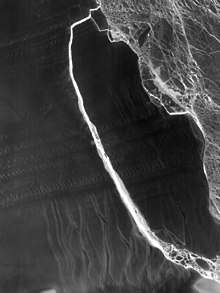Iceberg A-68
Iceberg A-68 calved from the Larsen C Ice Shelf in July 2017.[1][2][3] With a surface area of 5,800 square kilometres, twice the size of Luxembourg, larger than Delaware and weighing one trillion tonnes,[4] it is one of the largest recorded icebergs, the largest being B-15 which measured 11,000 square kilometres before breaking up. The calving of A-68 reduced the overall size of the Larsen C shelf by 12 percent.[4]


There is no projected path at this point; however, historical data shows many icebergs broken off from the Antarctic Peninsula reach the South Georgia and the South Sandwich Islands.[5]
The name "A-68" was assigned by the US National Ice Center.
History and recent developments
A-68 was part of Larsen C, a section of the Larsen Ice Shelf. The scientific community is divided whether the calving is the result of climate change, or merely a natural occurrence.[6] Scientists found the crack beginning to form in November 2016, and others suggested that it might have broken off as early as a decade ago. According to scientists observing the iceberg's path, A-68 "didn't just break through in one clean shot, [but] it formed a lace-network of cracks first."[4]
Satellite images from ESA and the European Union's Copernicus Program show that the iceberg is splintering, forming more icebergs in the process.[7]
Scientists are looking into the possibility of the ice shelf collapsing as a result of the split with A-68, or whether the iceberg was the "cork" for Larsen C that allows ice to flow more freely into the sea, thereby contributing to rising sea levels.[8]
Since November 2017, satellite images show A-68 is slowly drifting northward, with a widening gap to the main shelf. The gap was approximately five kilometers wide and contained a thin layer of loose, floating ice and a cluster of over 11 'smaller' bergs, one much larger than the rest.
A British expedition on RRS James Clark Ross intended to sample the marine life at A-68 cleavage line in March 2018, but had to turn back due to thick sea ice.[9]
In July 2018 A-68 started to drift northwards.[10]
On 9 December 2019 MS Expedition was the first ship to sight A-68 . On 6 February 2020 A-68 began to move into open waters.[11] On 10 March 2020 MV World Explorer spotted A-68a in position 61°45′S 51°33′W .
On 23 April 2020 a chunk measuring about 175 sq km broke free from the iceberg.[12]
Gallery
 Radar imagery from ESA's Sentinel-1B taken on 12 July 2017, showing the complete break
Radar imagery from ESA's Sentinel-1B taken on 12 July 2017, showing the complete break Iceberg A-68 on 12 July 2017
Iceberg A-68 on 12 July 2017 Close-up of Iceberg A-68 on 20 July 2017
Close-up of Iceberg A-68 on 20 July 2017 Closeup of the iceberg A-68 on 9th December 2019
Closeup of the iceberg A-68 on 9th December 2019 Second closeup of the iceberg A-68 on 9th December 2019
Second closeup of the iceberg A-68 on 9th December 2019 MS World Explorer at Iceberg A-68a with a spy-hopping Humpback Whale in the Weddell Sea
MS World Explorer at Iceberg A-68a with a spy-hopping Humpback Whale in the Weddell Sea
References
- "Larsen C calves trillion ton iceberg". Project MIDAS. 12 July 2017. Retrieved 12 July 2017.
- "Giant iceberg splits from Antarctic". BBC. 12 July 2017.
- "Massive iceberg breaks away from Antarctica". CNN. 12 July 2017. Retrieved 13 July 2017.
- Davis, Nicola (2 August 2017). "What happened next to the giant Larsen C iceberg?". The Guardian. ISSN 0261-3077. Retrieved 2 August 2017.
- Mosher, Dave (12 July 2017). "Where Antarctic iceberg from Larsen C shelf might go in Southern Ocean". Business Insider. Retrieved 21 July 2017.
- Luckman, Adrian. "I've studied Larsen C and its giant iceberg for years – it's not a simple story of climate change". The Conversation. Retrieved 2 August 2017.
- Dvorsky, George. "Antarctica's Massive Iceberg Is Starting to Disintegrate". Gizmodo. Retrieved 2 August 2017.
- Becker, Rachel (2 August 2017). "Cracks are still spreading where that massive Antarctic iceberg broke free". The Verge. Retrieved 2 August 2017.
- Amos, Jonathan (2 March 2018). "Mission to giant A-68 berg thwarted by sea-ice". BBC News. Retrieved 12 April 2018.
- Brandon, Mark. "A trillion tonnes of ice on the move: Iceberg A68A". Mallemaroking. Retrieved 31 August 2018.
- https://www.bbc.com/news/science-environment-51389690
- Amos, Jonathan (23 April 2020). "Is the world's biggest iceberg about to break up?". BBC News. Retrieved 28 April 2020.
External links

- Video of Iceberg A68A